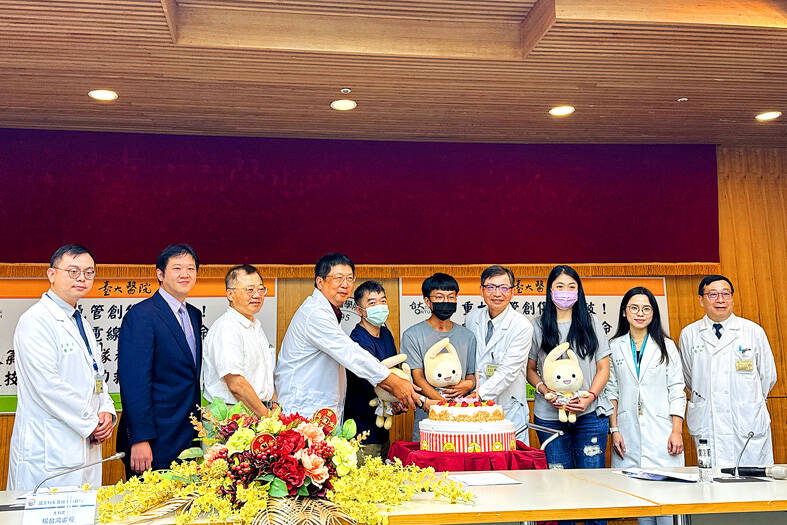A motorcycle rider who was strangled by a power line during a typhoon last year has become the world’s first person to have a traumatic tracheal rupture repaired using an aortic graft, the National Taiwan University Hospital (NTUH) said on Wednesday.
During Typhoon Koinu in October last year, a 24-year-old man surnamed Tseng (曾) was riding his motorcycle home from work in Yunlin County when the accident happened, NTUH Department of Surgery chairman Chen Jin-shing (陳晉興) said at a news conference.
After initial treatment at a local hospital, Tseng was transferred to NTUH’s Yunlin Branch, where further complications arose, including serious tracheal stenosis, forcing him to rely on a tracheostomy tube to breathe and a nasogastric tube to eat due to airway blockage, Chen said.

Photo: Chiu Chih-jou, Taipei Times
“Everyone can imagine how difficult it would be for a 24-year-old man to rely on tracheostomy and nasogastric tubes for the rest of his life,” Chen said.
Tseng was then referred to NTUH in Taipei, where Chen’s team in October last year performed a tracheal reconstruction using an aortic graft from an organ donor.
The patient recovered well after the surgery, and was off the ventilator the day after the operation and discharged in December, Chen said.
Tseng had his tracheostomy tube removed in April and has since returned to a normal life, regaining his ability to eat and speak, an NTUH news release said.
Such kinds of cases are rarely successful, as many patients either pass away at the scene or end up relying on a tracheostomy tube for the rest of their lives, Chen said.
That surgery was the world’s first instance of repairing a traumatic tracheal rupture using an aortic graft, and the case was accepted for publication last month by JTCVS Techniques, a peer-reviewed journal, he added.
Regarding the difficulty of performing the reconstruction, Chen said that while short tracheal lesions can be easily managed by resection and reconnection, lesions that are more than 5cm present significant challenges.
“When the trachea cannot be reconnected due to tumors, stenosis or severe trauma, reconstruction or even transplantation becomes necessary,” he said.
Tracheal reconstruction or transplantation that involved donated or artificial tracheas has long been a challenging task in pulmonology due to serious transplant rejection, he added.
Chen and his team, building on the work of French researcher Emmanuel Martinod in 2018, have successfully treated three patients with severe tracheal conditions since 2021 under a human clinical trial program approved by the Ministry of Health and Welfare, the news release said.
The team used a tissue-engineering technique involving aortic grafts stored at negative 80°C, which were thawed before implantation, and supported by tracheal stents to maintain their shape, eliminating the need for blood type matching and immunosuppressive drugs, it said.
Asked about the principle of the technique, Chen said that after an aorta is thawed, all the cells die, leaving only a structure similar to that of a trachea, which therefore does not trigger transplant rejection.
“It [the implanted aortic graft] acts like a bridge or an empty house... As the recipient’s [trachea] cells grow inside of it, they develop into mucosa and cartilage cells, gradually transforming the aorta into a trachea,” he said.

Chinese Nationalist Party (KMT) Chairman Eric Chu (朱立倫), spokeswoman Yang Chih-yu (楊智伃) and Legislator Hsieh Lung-chieh (謝龍介) would be summoned by police for questioning for leading an illegal assembly on Thursday evening last week, Minister of the Interior Liu Shyh-fang (劉世芳) said today. The three KMT officials led an assembly outside the Taipei City Prosecutors’ Office, a restricted area where public assembly is not allowed, protesting the questioning of several KMT staff and searches of KMT headquarters and offices in a recall petition forgery case. Chu, Yang and Hsieh are all suspected of contravening the Assembly and Parade Act (集會遊行法) by holding

PRAISE: Japanese visitor Takashi Kubota said the Taiwanese temple architecture images showcased in the AI Art Gallery were the most impressive displays he saw Taiwan does not have an official pavilion at the World Expo in Osaka, Japan, because of its diplomatic predicament, but the government-backed Tech World pavilion is drawing interest with its unique recreations of works by Taiwanese artists. The pavilion features an artificial intelligence (AI)-based art gallery showcasing works of famous Taiwanese artists from the Japanese colonial period using innovative technologies. Among its main simulated displays are Eastern gouache paintings by Chen Chin (陳進), Lin Yu-shan (林玉山) and Kuo Hsueh-hu (郭雪湖), who were the three young Taiwanese painters selected for the East Asian Painting exhibition in 1927. Gouache is a water-based

Taiwan would welcome the return of Honduras as a diplomatic ally if its next president decides to make such a move, Minister of Foreign Affairs Lin Chia-lung (林佳龍) said yesterday. “Of course, we would welcome Honduras if they want to restore diplomatic ties with Taiwan after their elections,” Lin said at a meeting of the legislature’s Foreign Affairs and National Defense Committee, when asked to comment on statements made by two of the three Honduran presidential candidates during the presidential campaign in the Central American country. Taiwan is paying close attention to the region as a whole in the wake of a

OFF-TARGET: More than 30,000 participants were expected to take part in the Games next month, but only 6,550 foreign and 19,400 Taiwanese athletes have registered Taipei city councilors yesterday blasted the organizers of next month’s World Masters Games over sudden timetable and venue changes, which they said have caused thousands of participants to back out of the international sporting event, among other organizational issues. They also cited visa delays and political interference by China as reasons many foreign athletes are requesting refunds for the event, to be held from May 17 to 30. Jointly organized by the Taipei and New Taipei City governments, the games have been rocked by numerous controversies since preparations began in 2020. Taipei City Councilor Lin Yen-feng (林延鳳) said yesterday that new measures by